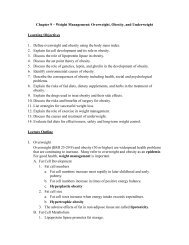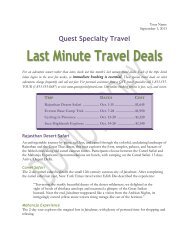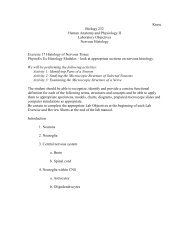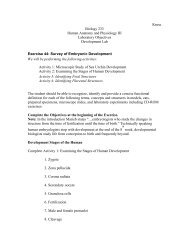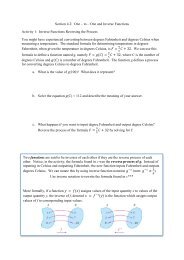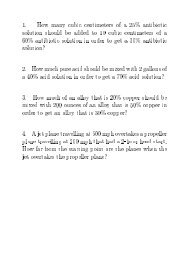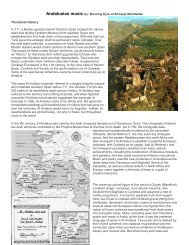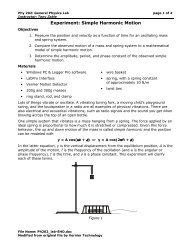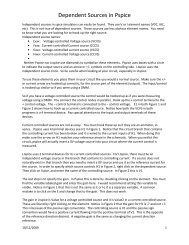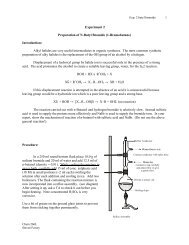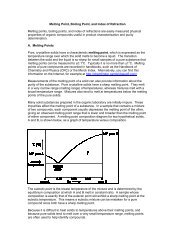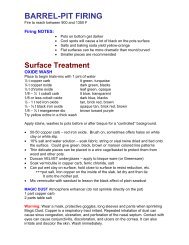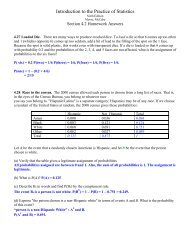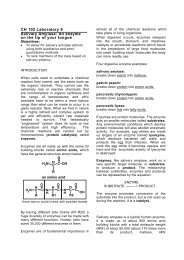BA213 Review for test # 2 - PCC
BA213 Review for test # 2 - PCC
BA213 Review for test # 2 - PCC
You also want an ePaper? Increase the reach of your titles
YUMPU automatically turns print PDFs into web optimized ePapers that Google loves.
<strong>BA213</strong> <strong>Review</strong> <strong>for</strong> <strong>test</strong> # 2 Key<br />
1. Contribution margin can be defined as:<br />
a. the amount of sales revenue necessary to cover variable expenses.<br />
b. sales revenue minus fixed expenses.<br />
c. the amount of sales revenue necessary to cover fixed and variable expenses.<br />
D. sales revenue minus variable expenses.<br />
2. If both the fixed and variable expenses associated with a product decrease, what will be the effect on the<br />
contribution margin ratio and the break-even point, respectively?<br />
a.<br />
B.<br />
c.<br />
d.<br />
3. The margin of safety can be calculated by:<br />
A. Sales - (Fixed expenses/Contribution margin ratio).<br />
b. Sales - (Fixed expenses/Variable expense per unit).<br />
c. Sales - (Fixed expenses + Variable expenses).<br />
d. Sales - Net operating income.
4. Sorin Inc., a company that produces and sells a single product, has provided its contribution <strong>for</strong>mat income<br />
statement <strong>for</strong> January.<br />
If the company sells 4,600 units, its total contribution margin should be closest to:<br />
a. $54,600<br />
B. $59,800<br />
c. $69,400<br />
d. $13,362<br />
Current contribution margin Current sales in units = Contribution margin per unit<br />
$54,600 4,200 = $13 contribution margin per unit<br />
If 4,600 units are sold, the total contribution margin will be 4,600 × $13, or $59,800.<br />
5. Decaprio Inc. produces and sells a single product. The company has provided its contribution <strong>for</strong>mat income<br />
statement <strong>for</strong> June.<br />
If the company sells 9,200 units, its net operating income should be closest to:<br />
a. $27,077<br />
b. $49,900<br />
C. $36,700<br />
d. $25,900<br />
Current sales dollars Current sales in units = Sales price per unit<br />
$528,000 8,800 = $60 sales price per unit<br />
Current variable expenses Current sales in units = Variable expense per unit<br />
$290,400 8,800 = $33 variable expense per unit
6. Jilk Inc.'s contribution margin ratio is 58% and its fixed monthly expenses are $36,000. Assuming that the<br />
fixed monthly expenses do not change, what is the best estimate of the company's net operating income in a<br />
month when sales are $103,000?<br />
A. $23,740<br />
b. $59,740<br />
c. $67,000<br />
d. $7,260<br />
7. Data concerning Kardas Corporation's single product appear below:<br />
The company is currently selling 8,000 units per month. Fixed expenses are $719,000 per month. The marketing<br />
manager believes that a $20,000 increase in the monthly advertising budget would result in a 180 unit increase<br />
in monthly sales. What should be the overall effect on the company's monthly net operating income of this<br />
change?<br />
a. decrease of $160<br />
b. increase of $20,160<br />
c. decrease of $20,000<br />
D. increase of $160<br />
Increase in net operating income: $177,160 - $177,000 = $160
8. Hartl Corporation is a single product firm with the following selling price and cost structure <strong>for</strong> next year:<br />
How many units will Hartl have to sell next year in order to break-even?<br />
a. 121,500<br />
b. 202,500<br />
C. 303,750<br />
d. 546,750<br />
Variable cost per unit = $1.80 × (1 - 40%)<br />
Variable cost per unit = $1.08<br />
Sales = Variable expenses + Fixed expenses + Profit<br />
$1.80Q = $1.08Q + $218,700 + $0<br />
$0.72Q = $218,700<br />
Q = $218,700 $0.72 per unit = 303,750 units<br />
9. Data concerning Buchenau Corporation's single product appear below:<br />
The break-even in monthly unit sales is closest to:<br />
a. 3,111<br />
b. 6,892<br />
C. 4,040<br />
d. 13,525<br />
Sales = Variable expenses + Fixed expenses + Profit<br />
$150.00Q = $34.50Q + $466,620 + $0<br />
$115.50Q = $466,620<br />
Q = $466,620 $115.50 per unit = 4,040 units
10. Data concerning Follick Corporation's single product appear below:<br />
The break-even in monthly dollar sales is closest to:<br />
a. $1,148,400<br />
b. $638,851<br />
c. $321,552<br />
D. $446,600<br />
Sales = Variable expenses + Fixed expenses + Profit<br />
$110.00Q = $30.80Q + $321,552 + $0<br />
$79.20Q = $321,552<br />
Q = $321,552 $79.20 per unit = 4,060 units<br />
4,060 units × $110.00 selling price = $446,600<br />
11. Caneer Corporation produces and sells a single product. Data concerning that product appear below:<br />
The unit sales to attain the company's monthly target profit of $44,000 is closest to:<br />
a. 7,896<br />
b. 12,769<br />
C. 6,578<br />
d. 4,341<br />
Sales = Variable expenses + Fixed expenses + Target profit<br />
$240.00Q = $81.60Q + $997,920 + $44,000<br />
$158.40Q = $1,041,920<br />
Q = $1,041,920 $158.40 per unit = 6,578 units (rounded)
12. Ensley Corporation has provided the following data concerning its only product:<br />
The margin of safety as a percentage of sales is closest to:<br />
a. 61%<br />
B. 28%<br />
c. 72%<br />
d. 39%<br />
Margin of safety in dollars:<br />
Break-even sales = $200 per unit × 21,816 = $4,363,200<br />
Current sales = $200 per unit × 30,300 = $6,060,000<br />
Margin of safety in dollars = Sales - Break-even sales<br />
= $6,060,000 - $4,363,200 = $1,696,800<br />
Margin of safety as a percentage of sales = Margin of safety in dollars Current sales = $1,696,800<br />
$6,060,000 = 28% (rounded)
13. Ostler Company's net operating income last year was $10,000 and its contribution margin was $50,000.<br />
Using the operating leverage concept, if the company's sales increase next year by 8 percent, net operating<br />
income can be expected to increase by:<br />
a. 20%<br />
b. 16%<br />
c. 160%<br />
D. 40%<br />
Degree of operating leverage = Contribution margin Net operating income<br />
Degree of operating leverage = $50,000 $10,000 = 5<br />
Percent increase in net operating income<br />
= Percent increase in sales × Degree of operating leverage<br />
= 8% × 5 = 40%<br />
14. E.D. Manufacturing, Inc. produces and sells ice skates. The current net operating income is $40,000, with a<br />
degree of operating leverage of 3. If sales increase by 10%, how much total net operating income should be<br />
expected?<br />
a. $12,000<br />
B. $52,000<br />
c. $44,000<br />
d. None of these.<br />
Percent increase in net operating income<br />
= Percent increase in sales × Degree of operating leverage<br />
= 10% × 3 = 30%<br />
Current net operating income × Percent increase = Increase in net operating income<br />
$40,000 × 30% = $12,000 Increase in net operating income<br />
Current net operating income + Increase in net operating income = Expected net operating income = $40,000 +<br />
$12,000 = $52,000
15. The Garry Corporation's most recent contribution <strong>for</strong>mat income statement is shown below:<br />
Required:<br />
Prepare a new contribution <strong>for</strong>mat income statement under each of the following conditions (consider each case<br />
independently):<br />
a. The sales volume increases by 10% and the price decreases by $0.50 per unit.<br />
b. The selling price decreases $1.00 per unit, fixed expenses increase by $15,000, and the sales volume<br />
decreases by 5%.<br />
c. The selling price increases by 25%, variable expense increases by $0.75 per unit, and the sales volume<br />
decreases by 15%.<br />
d. The selling price increases by $1.50 per unit, variable cost increases by $1.00 per unit, fixed expenses<br />
decrease by $15,000, and sales volume decreases by 12%.
a.<br />
b.<br />
c.<br />
d.<br />
16. A budget committee helps provide consistency in the budgeting process because it prepares all of the<br />
budgets <strong>for</strong> the various segments of the organization.<br />
FALSE
17. When using the self-imposed budget approach, it is generally best <strong>for</strong> top management to accept all budget<br />
estimates without question in order to minimize adverse behavioral responses from employees.<br />
FALSE<br />
18. The direct labor budget begins with sales in units from the sales budget.<br />
FALSE<br />
19. Which of the following budgets are prepared be<strong>for</strong>e the sales budget?<br />
a.<br />
b.<br />
c.<br />
D.<br />
20. All of Gaylord Company's sales are on account. Thirty-five percent of the credit sales are collected in the<br />
month of sale, 45% in the month following sale, and the rest are collected in the second month following sale.<br />
Bad debts are negligible and should be ignored. The following are budgeted sales data <strong>for</strong> the company:<br />
What is the amount of cash that should be collected in March?<br />
a. $39,000<br />
b. $37,000<br />
c. $27,500<br />
D. $51,000
21. Betz Company's sales budget shows the following projections <strong>for</strong> next year:<br />
Inventory at the beginning of the year was 18,000 units. The finished goods inventory at the end of each quarter<br />
is to equal 30% of the next quarter's budgeted unit sales. How many units should be produced during the first<br />
quarter?<br />
a. 24,000<br />
b. 48,000<br />
C. 66,000<br />
d. 72,000<br />
Units produced = Ending inventory + Units sold + Beginning inventory<br />
= (30% 80,000) + 60,000 - 18,000<br />
= 24,000 + 60,000 - 18,000 = 66,000<br />
22. Pooler Corporation is working on its direct labor budget <strong>for</strong> the next two months. Each unit of output<br />
requires 0.15 direct labor-hours. The direct labor rate is $7.00 per direct labor-hour. The production budget calls<br />
<strong>for</strong> producing 6,500 units in April and 6,200 units in May. The company guarantees its direct labor workers a<br />
40-hour paid work week. With the number of workers currently employed, that means that the company is<br />
committed to paying its direct labor work <strong>for</strong>ce <strong>for</strong> at least 1,000 hours in total each month even if there is not<br />
enough work to keep them busy. What would be the total combined direct labor cost <strong>for</strong> the two months?<br />
a. $13,825.00<br />
b. $13,335.00<br />
C. $14,000.00<br />
d. $13,510.00<br />
Direct labor-hours needed <strong>for</strong> production in April = 0.15 6,500 = 975<br />
Direct labor-hours needed <strong>for</strong> production in May = 0.15 6,200 = 930<br />
Even though both months' production needs would require less than 1,000 hours, the company has committed to<br />
paying a minimum of 1,000 hours per month.<br />
Total direct labor-hours = 1,000 + 1,000 = 2,000<br />
Direct labor cost = 2,000 $7 = $14,000
23. Schuepfer Inc. bases its selling and administrative expense budget on budgeted unit sales. The sales budget<br />
shows 1,300 units are planned to be sold in March. The variable selling and administrative expense is $4.20 per<br />
unit. The budgeted fixed selling and administrative expense is $19,240 per month, which includes depreciation<br />
of $3,380 per month. The remainder of the fixed selling and administrative expense represents current cash<br />
flows. The cash disbursements <strong>for</strong> selling and administrative expenses on the March selling and administrative<br />
expense budget should be:<br />
a. $15,860<br />
b. $5,460<br />
c. $24,700<br />
D. $21,320<br />
(1,300 $4.20) + ($19,240 - $3,380) = $5,460 + $15,860 = $21,320<br />
24. Francis Manufacturing Company is currently preparing its cash budget <strong>for</strong> next month and has gathered the<br />
following in<strong>for</strong>mation:<br />
The beginning cash balance will be $6,000 and the company requires a minimum cash balance at the end of the<br />
month of $5,000. How much will Francis Manufacturing need to borrow to meet its cash needs <strong>for</strong> the month?<br />
a. $9,100<br />
B. $14,100<br />
c. $20,100<br />
d. None of these.<br />
Actual ending cash balance = Beginning cash balance + Cash receipts - Cash disbursements = $6,000 + $39,400<br />
- ($12,000 + $9,000 + $11,500 + $22,000)<br />
= $45,400 - $54,500 = ($9,100)<br />
Amount borrowed = Desired ending cash balance - Actual ending cash balance<br />
= $5,000 - ($9,100) = $14,100<br />
Varughese Inc. is working on its cash budget <strong>for</strong> March. The budgeted beginning cash balance is $33,000.<br />
Budgeted cash receipts total $182,000 and budgeted cash disbursements total $191,000. The desired ending<br />
cash balance is $40,000.
25. The excess (deficiency) of cash available over disbursements <strong>for</strong> March will be:<br />
a. $215,000<br />
b. $42,000<br />
C. $24,000<br />
d. ($9,000)<br />
Excess cash available over disbursements = Beginning cash balance + Budgeted cash receipts - Budgeted cash<br />
disbursements = $33,000 + $182,000 - $191,000 = $24,000<br />
26. To attain its desired ending cash balance <strong>for</strong> March, the company needs to borrow:<br />
a. $40,000<br />
b. $0<br />
C. $16,000<br />
d. $64,000<br />
Excess cash available over disbursements = Beginning cash balance + Budgeted cash receipts - Budgeted cash<br />
disbursements = $33,000 + $182,000 - $191,000 = $24,000<br />
Borrowing = Desired ending cash balance - Excess cash available over disbursements = $40,000 - $24,000 =<br />
$16,000
27. The manufacturing overhead budget of Reigle Corporation is based on budgeted direct labor-hours. The<br />
February direct labor budget indicates that 5,800 direct labor-hours will be required in that month. The variable<br />
overhead rate is $4.60 per direct labor-hour. The company's budgeted fixed manufacturing overhead is $82,360<br />
per month, which includes depreciation of $16,820. All other fixed manufacturing overhead costs represent<br />
current cash flows.<br />
Required:<br />
a. Determine the cash disbursement <strong>for</strong> manufacturing overhead <strong>for</strong> February. Show your work!<br />
b. Determine the predetermined overhead rate <strong>for</strong> February. Show your work!<br />
a.<br />
b.<br />
28. In developing a direct material price standard, the expected freight cost on the materials should be included.<br />
TRUE<br />
29. The production department should generally be responsible <strong>for</strong> material price variances that resulted from:<br />
a. purchases made in uneconomical lot-sizes.<br />
B. rush orders arising from poor scheduling.<br />
c. purchase of the wrong grade of materials.<br />
d. changes in the market prices of raw materials.
30. Mayall Corporation is developing standards <strong>for</strong> its products. Each unit of output of the product requires 0.92<br />
kilogram of a particular input. The allowance <strong>for</strong> waste and spoilage is 0.02 kilogram of this input <strong>for</strong> each unit<br />
of output. The allowance <strong>for</strong> rejects is 0.11 kilogram of this input <strong>for</strong> each unit of output. The standard quantity<br />
in kilograms of this input per unit of output should be:<br />
a. 0.90<br />
b. 0.92<br />
c. 0.79<br />
D. 1.05<br />
31. The following materials standards have been established <strong>for</strong> a particular product:<br />
The following data pertain to operations concerning the product <strong>for</strong> the last month:<br />
What is the materials price variance <strong>for</strong> the month?<br />
a. $6,250 U<br />
B. $4,030 U<br />
c. $8,679 U<br />
d. $6,575 U<br />
Materials price variance = Actual quantity × (Actual price - Standard price)<br />
= $81,530 - (6,200 × $12.50)<br />
= $81,530 - $77,500<br />
= $4,030 unfavorable
32. (Appendix) Warmuth Corporation has provided the following data concerning its direct labor costs <strong>for</strong><br />
September:<br />
The Labor Efficiency Variance <strong>for</strong> September would be recorded as a:<br />
a. credit of $120,480.<br />
B. debit of $120,480.<br />
c. debit of $125,500.<br />
d. credit of $125,500.<br />
Standard hours = Standard hours per unit × Actual output<br />
= 8.8 × 6,600 = 58,080<br />
Labor efficiency variance = Standard rate × (Actual hours - Standard hours)<br />
= $12 × (68,120 - 58,080)<br />
= $120,480 unfavorable<br />
33. The following labor standards have been established <strong>for</strong> a particular product:<br />
The following data pertain to operations concerning the product <strong>for</strong> the last month:<br />
What is the labor rate variance <strong>for</strong> the month?<br />
a. $687 F<br />
b. $2,106 F<br />
C. $1,410 F<br />
d. $2,106 U<br />
Actual rate = Labor cost Actual hours<br />
= $107,630 9,400 = $11.45<br />
Labor rate variance = Actual hours × (Actual rate - Standard rate)<br />
= 9,400 × ($11.45 - $11.60) = $1,410 favorable
Kouri Corporation is developing standards <strong>for</strong> its products. One product requires an input that is purchased <strong>for</strong><br />
$85.00 per kilogram from the supplier. By paying cash, the company gets a discount of 4% off this purchase<br />
price. Shipping costs from the supplier's warehouse amount to $4.62 per kilogram. Receiving costs are $0.55<br />
per kilogram. Each unit of output of the product requires 0.74 kilogram of this input. The allowance <strong>for</strong> waste<br />
and spoilage is 0.03 kilogram of this input <strong>for</strong> each unit of output. The allowance <strong>for</strong> rejects is 0.13 kilogram of<br />
this input <strong>for</strong> each unit of output.<br />
Brewer - Chapter 008<br />
34. The standard price per kilogram of this input should be:<br />
a. $85.00<br />
B. $86.77<br />
c. $83.23<br />
d. $93.57<br />
35. The standard quantity in kilograms of this input per unit of output should be:<br />
a. 0.71<br />
b. 0.58<br />
C. 0.90<br />
d. 0.74<br />
Garrigus Corporation is developing direct labor standards. The basic direct labor wage rate is $14.00 per hour.<br />
Employment taxes are 10% of the basic wage rate. Fringe benefits are $3.53 per direct labor-hour. A particular<br />
product requires 0.74 direct labor-hours per unit. The allowance <strong>for</strong> breaks and personal needs is 0.05 direct<br />
labor-hours per unit. The allowance <strong>for</strong> cleanup, machine downtime, and rejects is 0.13 direct labor-hours per<br />
unit.<br />
Brewer - Chapter 008
36. The standard rate per direct labor-hour should be:<br />
a. $9.07<br />
b. $14.00<br />
C. $18.93<br />
d. $4.93<br />
37. The standard direct labor-hours per unit should be:<br />
a. 0.69<br />
b. 0.56<br />
c. 0.74<br />
D. 0.92<br />
Longview Hospital per<strong>for</strong>ms blood <strong>test</strong>s in its laboratory. The following standards have been set <strong>for</strong> each<br />
blood <strong>test</strong> per<strong>for</strong>med:<br />
During May, the laboratory per<strong>for</strong>med 1,500 blood <strong>test</strong>s. On May 1 there were no direct materials (plates) on<br />
hand; after a plate is used <strong>for</strong> a blood <strong>test</strong> it is discarded. Variable overhead is assigned to blood <strong>test</strong>s on the<br />
basis of direct labor hours. The following events occurred during May:<br />
• 3,600 plates were purchased <strong>for</strong> $9,540<br />
• 3,200 plates were used <strong>for</strong> blood <strong>test</strong>s<br />
• 340 actual direct labor hours were worked at a cost of $5,550<br />
Brewer - Chapter 008
38. The materials price variance <strong>for</strong> May is:<br />
A. $360 F<br />
b. $360 U<br />
c. $740 F<br />
d. $740 U<br />
Materials price variance = (Actual quantity purchased × Actual price) - (Purchase quantity × Standard price) =<br />
$9,540 - (3,600 × $2.75) = $360 favorable<br />
39. The materials quantity variance <strong>for</strong> May is:<br />
a. $1,650 F<br />
b. $1,650 U<br />
C. $550 U<br />
d. $720 F<br />
Standard quantity = Standard quantity per unit × Actual output<br />
= 2 × 1,500 = 3,000<br />
Materials quantity variance = Standard price × (Actual quantity - Standard quantity) = $2.75 × (3,200 - 3,000) =<br />
$550 unfavorable<br />
40. The labor rate variance <strong>for</strong> May is:<br />
a. $225 F<br />
b. $225 U<br />
c. $450 F<br />
D. $450 U<br />
Labor rate variance = (Actual hours × Actual rate) - (Actual hours × Standard rate)<br />
= $5,550 - (340 × $15) = $450 unfavorable<br />
41. The labor efficiency variance <strong>for</strong> May is:<br />
a. $600 F<br />
B. $600 U<br />
c. $515 U<br />
d. $515 F<br />
Standard hours = Standard hours per unit × Actual output<br />
= 0.2 × 1,500 = 300<br />
Labor efficiency variance = Standard rate × (Actual hours - Standard hours)<br />
= $15 × (340 - 300) = $600 unfavorable
42. The variable overhead efficiency variance <strong>for</strong> May is<br />
a. $350 F<br />
b. $350 U<br />
C. $280 U<br />
d. $280 F<br />
Standard hours = Standard hours per unit × Actual output<br />
= 0.2 × 1,500 = 300<br />
Variable overhead efficiency variance = Standard rate × (Actual hours - Standard hours) = $7 × (340 - 300) =<br />
$280 unfavorable



